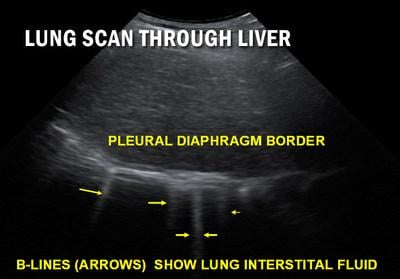
Sonogram taken under rib cage shows liver (grey) with curved diaphragm-lung border (white). Arrows point to vertical B lines (white) demonstrating diseased lung tissue. The more B lines the worse the disease. Healing is measured by reduction in the number of B lines.
April 6, 2020 — Robert L. Bard, M.D., NYC imaging specialist collaborates with an international group of medical leaders including Danilo Buonsenso, M.D., (Rome, Italy) who recently published reports about "ultrasound equipment as an effective replacement of the stethoscope." Buonsenso's review presents the valid uses and benefits of lung ultrasound in identifying respiratory disorders that may be associated with Covid-19.
Currently, front line physicians in Italy and Spain are reportedly triaging with portable ultrasound units that reduce logistical problems of a chaotic environment and healthcare worker exposure. Since imaging with computed tomography (CT) or ultrasound is not diagnostic, determining who needs hospitalization is essential in a pandemic overwhelming medical providers. Buonsenso, at the viral epicenter in Rome, uses sonograms to decide who requires a CT scan.
The use of CT lung imaging for COVID-19 has been recognized as the diagnostic standard during our current epidemic. Meanwhile, experts find CT to have disadvantages like radiation exposure. Respiratory distress creates motion artifacts on images that may simulate pulmonary inflammation. Also, viral pneumonia is not diagnostically distinguishable from other viral inflammations in the lung so the argument for a screening modality is useful to separate the critically ill from those needing outpatient treatment. This review was stated by Klaus Lessnau, M.D., author of "CHEST ULTRASOUND" (Springer 2003), employs both CT and ultrasound imaging in clinical practice.
Bard reviews international healthcare and technology updates as part of his continued research in the radiological society. This includes Buonsenso's national reports about the Covid-19 crisis and the expanded use of lung ultrasound as part of his investigation of children as clinically unaffected carriers. "The global pandemic demands effective answers toward a cure as well as protection of healthcare workers on duty," said Bard. "I have the highest regard for the European approach to problem solving both clinically and technologically… applying Dr. Buonsenso's concept makes perfect sense to me and carries great value in our war against Covid-19."
According to Bard, lung ultrasound has been used in emergency rooms since it was introduced to the Mt Sinai Medical School in 2014 and is now used nationwide to diagnose pneumonia (viral or bacterial) in children which spares them unnecessary X-rays since it is so accurate. "It is like an electronic stethoscope since lung disease and heart failure producing pulmonary fluid buildup are diagnosed or confirmed with portable ultrasound units at the bedside. This is considered the best imaging tool to diagnose a collapsed lung in seconds which has proven lifesaving as a time saver for on the spot detection."
In a recent telehealth conference, Bard explained how ultrasound probes study the lungs between the ribs to read the lung surface where most Covid-19 pathology is situated. Portable units have the advantage of containment within a sterile sleeve, preventing accidental viral spread to imaging equipment necessitating full decontamination procedures. All clinical imaging was correlated with the patient's oxygen saturation and clinical setting. The virus has known cardiac toxicity so the same sonogram unit may image the heart for fluid buildup and weakened contraction. This may differentiate heart failure from pulmonary infection in some cases which may have similar clinical presentations.
For more information: www.barddiagnostics.com
Related Coronavirus Content:
VIDEO: Imaging COVID-19 With Point-of-Care Ultrasound (POCUS)
The Cardiac Implications of Novel Coronavirus
CT Provides Best Diagnosis for Novel Coronavirus (COVID-19)
Radiology Lessons for Coronavirus From the SARS and MERS Epidemics
Deployment of Health IT in China’s Fight Against the COVID-19 Epidemic
Emerging Technologies Proving Value in Chinese Coronavirus Fight
Radiologists Describe Coronavirus CT Imaging Features
Coronavirus Update from the FDA
CT Imaging of the 2019 Novel Coronavirus (2019-nCoV) Pneumonia
CT Imaging Features of 2019 Novel Coronavirus (2019-nCoV)
Chest CT Findings of Patients Infected With Novel Coronavirus 2019-nCoV Pneumonia
Find more related clinical content Coronavirus (COVID-19)
ACC COVID-19 recommendations for the cardiovascular care team
VIDEO: What Cardiologists Need to Know about COVID-19 — Interview with Thomas Maddox, M.D.
The Cardiac Implications of Novel Coronavirus
ESC Council on Hypertension Says ACE-I and ARBs Do Not Increase COVID-19 Mortality



 August 09, 2024
August 09, 2024 








